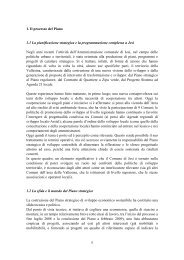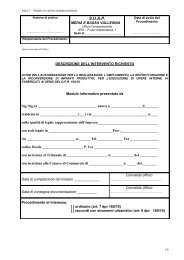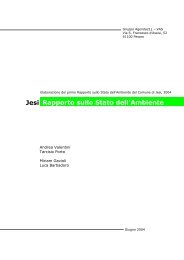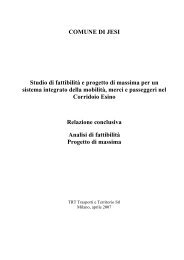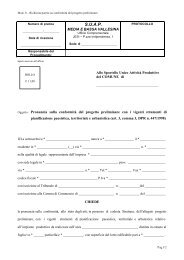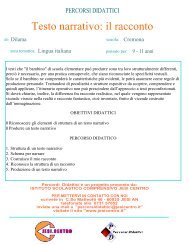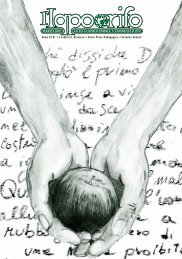Ippogrifo 1-2003:Ippogrifo 1/2003 - Comune di Jesi
Ippogrifo 1-2003:Ippogrifo 1/2003 - Comune di Jesi
Ippogrifo 1-2003:Ippogrifo 1/2003 - Comune di Jesi
You also want an ePaper? Increase the reach of your titles
YUMPU automatically turns print PDFs into web optimized ePapers that Google loves.
10<br />
5/03<br />
UN VIAGGIO ALLE ORIGINI<br />
DELLA STAMPA<br />
Sabato 5 ottobre 2002 la classe<br />
V A del Liceo Classico<br />
Statale “Vittorio Emanuele<br />
II” si è recata a Palazzo Pianetti<br />
Vecchio, ex monastero <strong>di</strong> clarisse<br />
e o<strong>di</strong>erna sede del S.A.S. o Museo<br />
delle Arti Grafiche.<br />
Nel 1450, con l’invenzione della<br />
stampa <strong>di</strong> Gutenberg, sorsero<br />
molte tipografie in Europa e, in<br />
quel periodo, Federico Conti nel<br />
1455 vi aprì la sua tipografia proprio<br />
a <strong>Jesi</strong>.<br />
L’invenzione della stampa fu una<br />
grande innovazione poiché sostituì<br />
il lavoro che prima veniva svolto<br />
dai monaci amanuensi.<br />
Nel museo, oltre a macchine tipografiche<br />
moderne, vi è un torchio<br />
del Settecento. Il torchio, interamente<br />
in legno, è composto da<br />
una vite senza fine, da un torcolo e<br />
da un carrello, su cui veniva posto<br />
il foglio; dopo questa operazione,<br />
veniva mosso il torcolo e le lettere,<br />
incise su caratteri mobili <strong>di</strong><br />
piombo, (posizionati sul compositoio)<br />
venivano così impresse sul<br />
foglio.<br />
Nel museo sono inoltre presenti<br />
parecchie copie <strong>di</strong> libri <strong>di</strong> cui vengono<br />
evidenziate le parti principali:<br />
- Il colofon<br />
- La miniatura<br />
- Il frontespizio<br />
- L’illustrazione<br />
- La marca tipografica<br />
Il colofon è la frase che l’autore scri-<br />
Il salone del Museo delle Arti Grafiche <strong>di</strong> <strong>Jesi</strong>.<br />
veva a termine della sua opera:<br />
solitamente è una frase <strong>di</strong> ringraziamento<br />
a Dio per avergli conferito<br />
la forza <strong>di</strong> portare a compimento<br />
la sua opera.<br />
La miniatura è la prima lettera del<br />
testo che i monaci amanuensi<br />
decoravano con oro e colori.<br />
Il frontespizio è la prima pagina del<br />
libro, in cui compaiono il titolo,<br />
l’autore del libro e anche la tipografia<br />
in cui è stato stampato.<br />
La marca tipografica è un piccolo<br />
<strong>di</strong>segno che variava da tipografia<br />
a tipografia e corrisponde all’attuale<br />
‘stemma” delle varie case e<strong>di</strong>trici.<br />
Nel museo sono presenti un’e<strong>di</strong>zione<br />
dell’Iliade in greco, vari volumi<br />
per l’insegnamento della musica<br />
gregoriana e una copia della<br />
Divina Comme<strong>di</strong>a che appartiene<br />
alla categoria degli incunaboli.<br />
Gli incunaboli sono i libri stampati<br />
prima del Cinquecento e prendono<br />
il loro nome dal termine<br />
latino incunabulum (culla): essi conservano<br />
le caratteristiche <strong>di</strong> manoscritti<br />
perchè il popolo non li avrebbe<br />
accettati, dal momento che essi<br />
erano una novità per quel periodo.<br />
Negli incunaboli non compaiono<br />
il frontespizio nè la miniatura;<br />
compaiono le iniziali<br />
xilografiche, ossia le miniature<br />
“stampate”.<br />
La copia della Divina Comme<strong>di</strong>a<br />
conservata nel museo è una delle<br />
tre che appartengono alle e<strong>di</strong>zioni<br />
principi ed è il primo libro che è<br />
stato stampato a <strong>Jesi</strong>. Le altre due<br />
copie sono conservate a Foligno<br />
e a Mantova. Il primo libro stampato<br />
della storia è un’e<strong>di</strong>zione<br />
della Bibbia pubblicata da<br />
Gutenberg.<br />
Alla fine della visita agli alunni è<br />
stata proposta un’interessante attività:<br />
sono stati <strong>di</strong>visi in gruppi e<br />
sono state <strong>di</strong>stribuite loro delle<br />
immagini nelle quali dovevano<br />
THREE<br />
WONDERFUL<br />
DAYS!<br />
You have probably heard<br />
about it and this time it<br />
was our turn!….<br />
We are the students of the third<br />
year of Liceo delle Scienze Sociali<br />
and Liceo Socio-Psico-Pedagogico<br />
and on the 27 th and 28 th of<br />
February and on the 1 st of March<br />
we participated in the activity that<br />
every year is held in our school:<br />
THREE DAYS IN ENGLISH.<br />
The two classes were <strong>di</strong>vided into<br />
three groups: the RAINBOW, the<br />
CHILD and the DOVE. In the<br />
first two days every group had to<br />
prepare something <strong>di</strong>fferent guided<br />
by our English teachers: Mrs<br />
Maceratini, Mrs Ragaglia and our<br />
English assistant Julia.<br />
This year we dealt with the world<br />
of children and their games.<br />
The group of CHILD and DOVE<br />
prepared tra<strong>di</strong>tional English nursery<br />
rhymes, chants, songs for skipping<br />
the rope, counting rhymes<br />
and miming songs.<br />
We have chosen rhymes that have<br />
been sung and repeated by English<br />
children for many generations and<br />
we enjoyed learning them very<br />
much. For a short time we went<br />
back to our childhood, we behaved<br />
like little children.<br />
The group of the RAINBOW<br />
worked on the famous tale “Little<br />
Red Ri<strong>di</strong>ng Hood”: a group prepared<br />
the tra<strong>di</strong>tional version,<br />
essere riconosciute le varie parti<br />
precedentemente menzionate: il<br />
colofon, le miniature, la marca tipografica,<br />
il frontespizio e l’illustrazione.<br />
Valentina Carboni<br />
Ilaria Marrocchi<br />
Jessica Sebastianelli<br />
Roberta Tittarelli<br />
L.C. , V A<br />
another a very modern remake of<br />
it and a third a funny rhyme by<br />
Roal Dahl.<br />
On the third day we presented our<br />
works to the other schoolmates:<br />
of course we not only tried to live<br />
our part to our best, but we also<br />
dressed up as children.<br />
On the second day we organised<br />
an ENGLISH LUNCH with typical<br />
English food which we prepared<br />
ourselves, and we invited<br />
our teachers and our Headmaster<br />
to enjoy the meal together. They<br />
seemed to appreciate it!<br />
In the afternoon we played some<br />
games and an exciting TREASU-<br />
RE HUNT which aroused all our<br />
energy and enthusiasm.<br />
At the end we can say that those<br />
were three very hard days, sometimes<br />
the activities were deman<strong>di</strong>ng<br />
and stressing but never<br />
boring. We all feel it was a good<br />
experience: we have improved<br />
our English learning new words<br />
and using the language in a <strong>di</strong>ffer<br />
e n t w ay , w e h av e l e a r n t<br />
something new about English life<br />
and above all we enjoyed working<br />
with pupils of another class and<br />
we had the chance to get to know<br />
each other better.<br />
Eleonora Bastari<br />
Lorena Massaccesi<br />
L.S.P.P., III B




